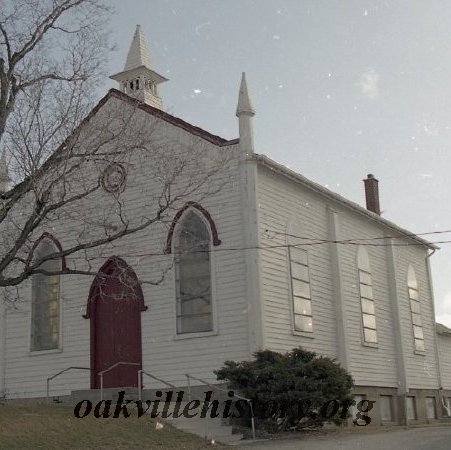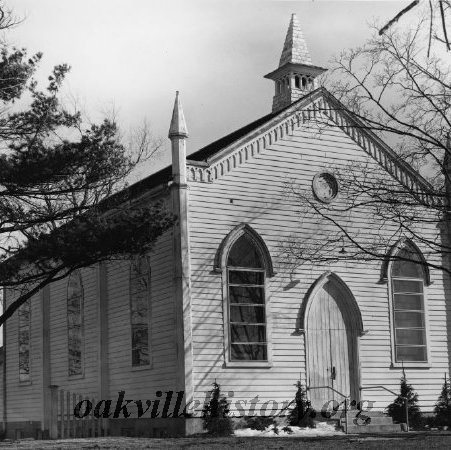Address:
3114 Dundas Street West - St. Luke's Anglican Church, Palermo
Summary:
The church was established in 1842, the building dates to 1845
Property Details:
St. Luke's Anglican Church sits on parts of what were Lots 31 and 32, Concession 1, South of Dundas Street. Dundas Street was surveyed in 1793 and became the base line for the original land survey conducted by Samuel Wilmot in 1806 following the Mississauga Purchase of 1805. Wilmot laid out four concessions to the south and two to the north.
In 1808 the 200-acre Lot 31, was granted by the Crown to Benjamin Smith. Starting in 1831, the land was gradually split up into smaller pieces. In 1845 Smith sold ¼ acre of it to Jacob Fisher and others, Trustees, for a parsonage lot. In 1875, Fisher, John Inglehart, Edward Sheridan, Wm C Inglehart, Lawrence Hager, Trustees of the English Church of Canada in Palermo and Robert B. Derrick (?) Minister of said church sold this lot to William Roberts.
Also in 1808, the lot to the west, the 200-acre Lot 32, was granted by the Crown to Fisher. In 1820 Fisher sold it to John Inglehart Jr and in January 1845, Inglehart donated 1 acre of it to the Church Society of the Diocese of Toronto.
Construction of the first church on the site started that year and the new church opened for worship on 1 March 1846. It was built by William Peacock, an early and prominent settler in Palermo, using lumber harvested from the site. The church, however, was not officially consecrated until 1868 when the construction debt was paid off. Services were provided by the rector in Oakville until 1874 when Rev E.A. Taylor was appointed. In 1902 Rev A.J. Belt was appointed at both Palermo and Omagh, to the north. Shortly after St. John's in Nelson Township was added to make a three-point parish. Apparently, the church was closed for several years around the turn of the 20th century but was re-opened in 1908.
As there was no Anglican church in the area before that, Peacock ran services in his house from about 1835 until the building was opened. He also donated a small melodeon which he played at services. He and his wife, Harriet, are buried in the churchyard behind the building.
A belfry was added in 1932. In 1951, the building was raised and a new basement put underneath. Fairly recently it was moved to the northeast to allow for the construction of a new church hall and community centre. The building was designated under Part IV of the Ontario Heritage Act in 2010. It was built in the Regency Gothic Revival style and is one of two remaining wood churches in Oakville.
The churchyard cemetery also has distinct historical value through its associations with the early settlers buried in the grounds. Grave markers date back to at least 1814, decades before the construction of the church.
In 1808 the 200-acre Lot 31, was granted by the Crown to Benjamin Smith. Starting in 1831, the land was gradually split up into smaller pieces. In 1845 Smith sold ¼ acre of it to Jacob Fisher and others, Trustees, for a parsonage lot. In 1875, Fisher, John Inglehart, Edward Sheridan, Wm C Inglehart, Lawrence Hager, Trustees of the English Church of Canada in Palermo and Robert B. Derrick (?) Minister of said church sold this lot to William Roberts.
Also in 1808, the lot to the west, the 200-acre Lot 32, was granted by the Crown to Fisher. In 1820 Fisher sold it to John Inglehart Jr and in January 1845, Inglehart donated 1 acre of it to the Church Society of the Diocese of Toronto.
Construction of the first church on the site started that year and the new church opened for worship on 1 March 1846. It was built by William Peacock, an early and prominent settler in Palermo, using lumber harvested from the site. The church, however, was not officially consecrated until 1868 when the construction debt was paid off. Services were provided by the rector in Oakville until 1874 when Rev E.A. Taylor was appointed. In 1902 Rev A.J. Belt was appointed at both Palermo and Omagh, to the north. Shortly after St. John's in Nelson Township was added to make a three-point parish. Apparently, the church was closed for several years around the turn of the 20th century but was re-opened in 1908.
As there was no Anglican church in the area before that, Peacock ran services in his house from about 1835 until the building was opened. He also donated a small melodeon which he played at services. He and his wife, Harriet, are buried in the churchyard behind the building.
A belfry was added in 1932. In 1951, the building was raised and a new basement put underneath. Fairly recently it was moved to the northeast to allow for the construction of a new church hall and community centre. The building was designated under Part IV of the Ontario Heritage Act in 2010. It was built in the Regency Gothic Revival style and is one of two remaining wood churches in Oakville.
The churchyard cemetery also has distinct historical value through its associations with the early settlers buried in the grounds. Grave markers date back to at least 1814, decades before the construction of the church.



